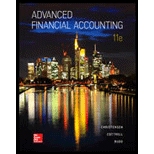
a
Sale of subsidiary common shares: When a parent sells subsidiary shares, a gain or loss normally occurs and is recorded on the seller’s books, which needed to be recognized in consolidated net income. Under ASE 810, changes in a parent’s ownership interest in a subsidiary while the parent retains control require an adjustment to the amount assigned to the non-controlling interest to reflect its change in ownership in the subsidiary. Any difference in fair value of the controlling interest results in an adjustment to the
The reporting of sale of stock of a subsidiary by X Corporation in its consolidated financial statements prior to 2008, and the sale reported under current standards.
b
Sale of subsidiary common shares: When a parent sells subsidiary shares, a gain or loss normally occurs and is recorded on the seller’s books, which needed to be recognized in consolidated net income. Under ASE 810, changes in a parent’s ownership interest in a subsidiary while the parent retains control require an adjustment to the amount assigned to the non-controlling interest to reflect its change in ownership in the subsidiary. Any difference in fair value of the controlling interest results in an adjustment to the stockholders' equity attributable to the controlling interest, through an adjustment to additional paid-in capital.
The treatment of subsidiary
Want to see the full answer?
Check out a sample textbook solution
Chapter 9 Solutions
Advanced Financial Accounting
- Griffin Manufacturing reported an unadjusted cost of goods sold (COGS) of $105,000 for the year 20X2. During the year, the company experienced several variances, including a $6,000 unfavorable direct labor efficiency variance, a $2,500 favorable direct labor rate variance, a $5,500 unfavorable direct materials price variance, and a $4,000 unfavorable direct materials usage variance. There were no overhead variances reported. Based on this information, what is Griffin Manufacturing’s adjusted cost of goods sold for 20X2?arrow_forwardPlease explain the solution to this general accounting problem using the correct accounting principles.arrow_forwardNeed help general accounting questionarrow_forward
- Please help me solve this general accounting question using the right accounting principles.arrow_forwardJustin Company issued stock to Tom Justin in exchange for his investment of $78,000 cash in the business. The company recorded revenues of $645,000 and expenses of $572,000, and the company paid dividends of $35,000. What was Justin's net income for the year?arrow_forwardFinancial Accountingarrow_forward
 Auditing: A Risk Based-Approach (MindTap Course L...AccountingISBN:9781337619455Author:Karla M Johnstone, Audrey A. Gramling, Larry E. RittenbergPublisher:Cengage Learning
Auditing: A Risk Based-Approach (MindTap Course L...AccountingISBN:9781337619455Author:Karla M Johnstone, Audrey A. Gramling, Larry E. RittenbergPublisher:Cengage Learning EBK CONTEMPORARY FINANCIAL MANAGEMENTFinanceISBN:9781337514835Author:MOYERPublisher:CENGAGE LEARNING - CONSIGNMENT
EBK CONTEMPORARY FINANCIAL MANAGEMENTFinanceISBN:9781337514835Author:MOYERPublisher:CENGAGE LEARNING - CONSIGNMENT Auditing: A Risk Based-Approach to Conducting a Q...AccountingISBN:9781305080577Author:Karla M Johnstone, Audrey A. Gramling, Larry E. RittenbergPublisher:South-Western College Pub
Auditing: A Risk Based-Approach to Conducting a Q...AccountingISBN:9781305080577Author:Karla M Johnstone, Audrey A. Gramling, Larry E. RittenbergPublisher:South-Western College Pub Financial Accounting: The Impact on Decision Make...AccountingISBN:9781305654174Author:Gary A. Porter, Curtis L. NortonPublisher:Cengage Learning
Financial Accounting: The Impact on Decision Make...AccountingISBN:9781305654174Author:Gary A. Porter, Curtis L. NortonPublisher:Cengage Learning Cornerstones of Financial AccountingAccountingISBN:9781337690881Author:Jay Rich, Jeff JonesPublisher:Cengage Learning
Cornerstones of Financial AccountingAccountingISBN:9781337690881Author:Jay Rich, Jeff JonesPublisher:Cengage Learning Intermediate Accounting: Reporting And AnalysisAccountingISBN:9781337788281Author:James M. Wahlen, Jefferson P. Jones, Donald PagachPublisher:Cengage Learning
Intermediate Accounting: Reporting And AnalysisAccountingISBN:9781337788281Author:James M. Wahlen, Jefferson P. Jones, Donald PagachPublisher:Cengage Learning





